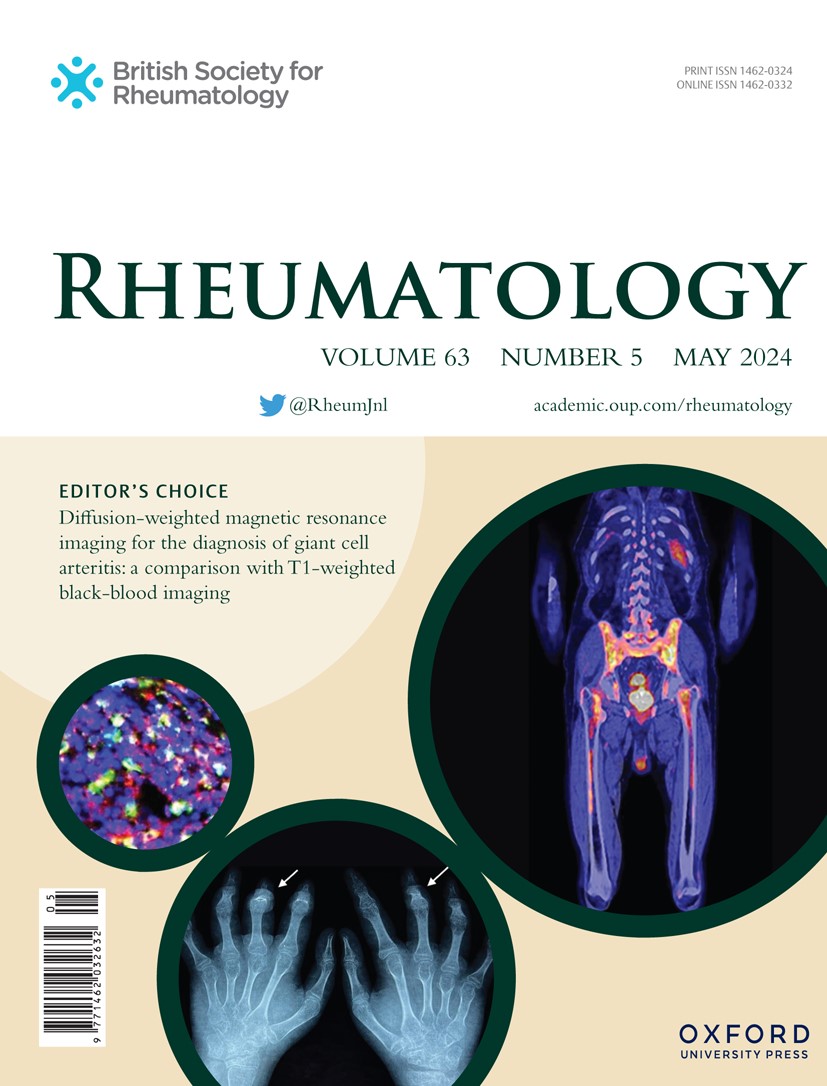Methyl-prednisolone plus methotrexate-based regime vs prednisone-based standard of care for giant cell arteritis: a propensity score study
IF 4.4
2区 医学
Q1 RHEUMATOLOGY
引用次数: 0
Abstract
Objectives Treatment of giant cell arteritis (GCA) still requires substantial exposure to glucocorticoids (GC), which are associated with significant toxicity. This study compares the efficacy and safety of the GC-only standard of care (SOC) with a regimen combining intravenous methyl-prednisolone (IVMP) pulses, methotrexate (MTX) and lower-doses of prednisone, in newly diagnosed patients with GCA. Methods A usual clinical practice study was conducted in three Spanish academic hospitals. 151 patients diagnosed with GCA were treated with SOC-prednisone (40–60 mg/d) or with IVMP (125–500 mg/d x3) followed by lower-dose prednisone (≤30 mg/d) and MTX (IVMP/MTX), with a follow-up of 2 years. A propensity score was used to adjust for baseline differences in the multivariate analyses. Results 79 (52.3%) patients received SOC-prednisone and 72 (47.7%) IVMP/MTX. The clinical characteristics at baseline were similar in both groups. 100% patients achieved remission after a median time of 4 weeks, without differences between groups. Relapse rates were also similar. Patients receiving IVMP/MTX had significantly lower cumulative GC doses and reached prednisone ≤5 mg/d faster than SOC patients (mean 13.8 vs 56.5 weeks; p< 0.001). Patients in the IVMP/MTX group were less likely to suffer any GC-related adverse effect (adjusted OR 0.35, 95%CI 0.14–0.85; p= 0.021). Conclusions The combination IVMP/MTX with lower-dose prednisone is as effective as the SOC in inducing remission and preventing relapses in GCA. The IVMP/MTX scheme significantly reduces GC exposure and GC-associated adverse effects. IVMP/MTX could be a potential GC-sparing strategy, especially in patients with GCA at higher risk of GC toxicity.甲基强的松龙加甲氨蝶呤治疗方案vs以强的松为基础的巨细胞动脉炎标准治疗:倾向评分研究
巨细胞动脉炎(GCA)的治疗仍然需要大量暴露于糖皮质激素(GC),这与显著的毒性有关。这项研究比较了GC-only标准护理(SOC)与静脉注射甲基强的松龙(IVMP)脉冲、甲氨蝶呤(MTX)和低剂量强的松治疗方案在新诊断的GCA患者中的疗效和安全性。方法在西班牙三所学术医院进行常规临床实践研究。151例诊断为GCA的患者接受soc -强的松(40-60 mg/d)或IVMP (125-500 mg/d x3)治疗,然后是低剂量强的松(≤30 mg/d)和MTX (IVMP/MTX),随访2年。倾向评分用于调整多变量分析中的基线差异。结果79例(52.3%)接受soc -强的松治疗,72例(47.7%)接受IVMP/MTX治疗。两组患者基线时的临床特征相似。100%的患者在4周后达到缓解,组间无差异。复发率也相似。与SOC患者相比,接受IVMP/MTX治疗的患者累积GC剂量显著降低,且达到强的松≤5mg /d的速度更快(平均13.8周vs 56.5周;p< 0.001)。IVMP/MTX组患者发生gc相关不良反应的可能性较小(调整后OR 0.35, 95%CI 0.14-0.85; p= 0.021)。结论IVMP/MTX联合低剂量强的松在诱导缓解和预防GCA复发方面与SOC同样有效。IVMP/MTX方案显著减少GC暴露和GC相关的不良反应。IVMP/MTX可能是一种潜在的GC节约策略,特别是对于GC毒性风险较高的GCA患者。
本文章由计算机程序翻译,如有差异,请以英文原文为准。
求助全文
约1分钟内获得全文
求助全文
来源期刊

Rheumatology
医学-风湿病学
CiteScore
9.40
自引率
7.30%
发文量
1091
审稿时长
2 months
期刊介绍:
Rheumatology strives to support research and discovery by publishing the highest quality original scientific papers with a focus on basic, clinical and translational research. The journal’s subject areas cover a wide range of paediatric and adult rheumatological conditions from an international perspective. It is an official journal of the British Society for Rheumatology, published by Oxford University Press.
Rheumatology publishes original articles, reviews, editorials, guidelines, concise reports, meta-analyses, original case reports, clinical vignettes, letters and matters arising from published material. The journal takes pride in serving the global rheumatology community, with a focus on high societal impact in the form of podcasts, videos and extended social media presence, and utilizing metrics such as Altmetric. Keep up to date by following the journal on Twitter @RheumJnl.
 求助内容:
求助内容: 应助结果提醒方式:
应助结果提醒方式:


